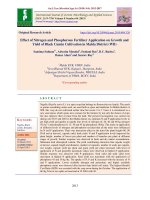Effect of ridge and furrow seed cum fertilizer drill on growth characters and yield of soybean (Glycine max) in Shajapur district of Madhya Pradesh, India
Bạn đang xem bản rút gọn của tài liệu. Xem và tải ngay bản đầy đủ của tài liệu tại đây (312.35 KB, 7 trang )
Int.J.Curr.Microbiol.App.Sci (2019) 8(4): 2298-2304
International Journal of Current Microbiology and Applied Sciences
ISSN: 2319-7706 Volume 8 Number 04 (2019)
Journal homepage:
Original Research Article
/>
Effect of Ridge and Furrow Seed cum Fertilizer Drill on
Growth Characters and Yield of Soybean (Glycine max) in
Shajapur District of Madhya Pradesh, India
S.S. Dhakad1*, G.R. Ambawatia2, Mukesh Singh1 and Gayatri Verma1
1
RVSKVV Krishi Vigyan Kendra Shajapur (MP)-465001, India
2
College of Agriculture (RVSKVV) Indore (MP), India
*Corresponding author
ABSTRACT
Keywords
Soybean, Seedcum-fertilizer drill,
Growth character,
Yield
Article Info
Accepted:
17 March 2019
Available Online:
10 April 2019
A field experiments was conducted during kharif season 2016 to 2017 for
soybean crop to assess ridge and furrow seed cum fertilizer drill. Seed-cumfertilizer drill was found better in term of growth characters and yield of
soybean in comparison with simple seed drill sowing machine. The net
return is the best index of profitability of soybean crop and higher net
return per ha of Rs 25144 was recorded for soybean crop under seed cum
fertilizer drill where as lower net return per ha of Rs 18025 was recorded
under normal seed drill sowing.
Introduction
MP has a unique distinction of having more
than 87% soybean (Glycine max) (Dwivedi et
al., 2006) area of the country and is rightly
designated as Soya State. Mechanization of
agriculture has assumed greater importance
for increasing agricultural production and
productivity by efficiently and effectively
utilizing scarce resources and costly farm
inputs improving timeliness factor, reducing
labour cost and human drudgery etc for
soybean & wheat cropping system. The basic
objective of sowing operation is to put the
seed and fertilizer in rows at desired depth
and seed to seed spacing, cover the seeds with
soil and provide proper compaction over the
seed.
The machinery such as raised bed planter,
conventional seed cum fertilizer drill, ridge
and furrow planter, broad bed planter and
zero till seed cum fertilizer drill respectively
used to sow the seed on raised bed in better
pulverized soil so that the minimum
compaction of soil over sown seed, promote
2298
Int.J.Curr.Microbiol.App.Sci (2019) 8(4): 2298-2304
seed emergence, higher moisture availability
to the plants and better drainage facility
during rainfall from furrow are available for
sowing of soybean of soybean crop. Whereas,
the conventional seed cum fertilizer drill is
used to sow the seed on well prepared seed
bed and levelled field with minimum
compaction of soil on the sown seed but it
requires irrigation in planting for better
germination.
soil.Ali and Behera (2014) reported that the
performance of soybean was better in raisedbed than flat-bed conventional system of
planting. Beneficial effects of ridge and
furrow method of sowing on soybean yield
have been reported through an improved soil
aeration, moisture, temperatures, better root
development and nitrogen fixation (Tisdall
and Hodgson, 1990; Jayapaul et al., 1995;
Jain and Dubey, 1998; Raut et al., 2000).
It facilitates manual and mechanical weeding
between rows, optimum plant population,
even with reduced seed rate, lower and more
efficient seeding rate than broadcasting. Row
seeding also promotes maximum tillering and
better sunlight penetration. Though the best
placement depends upon the kind of crop, the
nature of soil, the type of fertilizer salt and the
climatic conditions, it has been conclusively
proved that placing any kind of fertilizer in a
band 30-50 mm to the side and 20-30 mm
deep to the seed is safe and effective for most
of the crops (Martin and Leonard, 1976 and
Kepner et al., 1987).
Dixit et al., (2004) concluded that no-till seed
cum fertilizer drill has resulted in 17.09%
increase in yield, 83.22% saving in energy
and 80.34% saving in cost of production over
conventional seed drill. Rawat et al., (2007)
concluded that the zero till ferti seed drill was
found energy efficient and cost efficient
compared to conventional sowing of wheat on
the basis of energy ratio, specific energy and
benefit cost ratio.Ram & Singh. (2011)
conducted an experiment on four sowing
methods namely raised bed planting, raised
broad bed planting, ridge-furrow. sowing and
flat sowing for soybean crop. The highest
seed yield was recorded in raised bed sowing,
which was 6.70 and 5.29% higher than
ridgefurrow and flat sowing methods,
respectively.
Nimje et al., (2003) concluded that use of
improved seeding machines such as seedcum-fertilizer drill and strip-till seed-cumfertilizer drill reduced the cost of operation by
Rs 935 and Rs 1,578/ha and increased the net
income by Rs 2,589 and Rs 3,703/ha,
respectively, over the local seed drills used by
the farmers. They also conclude that planting
density of 440,000/ha increased the seed yield
by 61.6% and the net returns by Rs 6, 669/ha
over farmers’ practice in farmers’ field in
Bhopal district. Jat and Singh (2003) reported
higher biological yield and highest net and
gross return from land configuration treatment
as compared to conventional system has been
reported. Shukla (1987 and 2001),
Shrivastava (2005) and Choudhary (2002)
reported that the performance of strip, zero
and conventional till system for wheat
cropping gave better results in the light
The study has revealed that it is possible to
save machine labour and irrigation water
under zero tillage than under conventional
method an due to resource saving, net return
has been significantly higher in zero tillage
technology (Tripathi et al.,, 2013).
Muhammad et.al (2013) concluded from the
results that tillage implements followed by
rotavator showed better performance in terms
of number of tillers and harvest index of
wheat than sole use of tine cultivator twice
and sowing by drill produced better results in
terms of emergence, number of tillers, spike
length and harvest index as compared to
broadcasting. Patro et al., (2014) was
conducted experiment on four sowing
2299
Int.J.Curr.Microbiol.App.Sci (2019) 8(4): 2298-2304
methods (conventional sowing, seed-cumfertilizer drill sowing, paired row sowing and
criss-cross sowing) on groundnut production
and concluded that paired row sowing gave
significantly highest pod yield and net returns
(1781 kg ha−1 and Rs 19730 ha−1
respectively). Paired row sowing also
improved various yield associated attributes
viz., number of pegs (35.1) and pod plant−1
(27.6), shelling percentage (66.6) and 100kernel weight (33.6 g), and profitability (Rs
19,730) in groundnut. Dhakad and Khedkar
(2014) concluded that field demonstration
was conducted during kharif season 2012 to
2013 to study effect of seed-cum-fertilizer
drill sowing machine for soybean crop that
soybean sown by seed-cum-fertilizer drill was
found better in term of growth characters and
economics parameters with comparison to
simple seed drill sowing machine. With a
view to generate information, a field
experiment was conducted at at farmer’s
fields to observe effect of seed-cum-fertilizer
drill sowing machine on the growth characters
and yield of soybean.
for storing rainwater in furrows for enriching
soil moisture through percolation in case of
deficit rainfall. The soil moisture thus stored
sustains the crop during dry spells. The plant
growth character and yield contributing data
such as plant height, number of branches per
plant, number of root nodules per plant,
number of pods per plant, seed index (weight
of 100 seeds), seed yield, stover yield, harvest
index (%),net monetary returns, benefit: cost
ratio (B: C ratio) were recorded for soybean
crop. Nimje et al., (2002) and Dhakad et al.,
(2014) reported that effect of seed-cumfertilizer drill sowing machine for soybean
crop. The machine parameters (Time required
in sowing, diesel consumption, ffield capacity
of implement, require labour and cost of
operation during sowing) were measured from
seed-cum-fertilizer drill and seeddrill sowing
machine. The observations plant height,
number of branches per plant, number of root
nodules per plant, number of pods per plant,
seed index, seed yield, straw yield, harvest
index and economics of treatments were
calculated for continuously two years for
soybean crop.
Materials and Methods
The field experiments were conducted at the
farmer’s fields during kharif seasons 2016
and 2017 for soybean crop in the selected
village under operational area of Krishi
Vigyan Kendra Shajapur to assess the effect
of ridge and furrow attach seed cum fertilizer
drill machine on yield and economics of
soybean crop. To make the ridge and furrow
system an extra punji is attached on the back
tines of tractor operated seed-cum-fertilizer
drill machine. The width of panji depends
upon the row to row distances. Sowing seeds
by front line tines and covering them by soil
took place by punji attached in back line tines.
Thus lines of soybean automatically come
over ridge favoured by formation of alternate
furrows. These furrows are useful to drain out
excessive rainwater during heavy storms and
Measurement of different parameters for
soybean
Plant height
Plant height at 60 days after sowing, and at
harvest stage was recorded. In plot five plants
were selected randomly and tagged for
periodic observation. The height (cm) was
recorded at 60 DAS and at harvest stage of
the crop in all the plots. It was measured from
the ground surface to the main stem apex.
Number of branches per plant
Number of branches was recorded at 60 DAS
and at harvest stage of the crop in all the
plots. It was measured on five plants which
were selected randomly and tagged.
2300
Int.J.Curr.Microbiol.App.Sci (2019) 8(4): 2298-2304
Where, the biological yield = Seed yield +
Stover yield
Number of root nodules per plant
Nodulation studies of soybean were done
from 5 random plants in each plot. Five plants
dug up randomly in each plot and the nodules
were washed out and counted. This study was
done at 60 days after sowing.
Number of pods per plant
The total number of pods of five plants was
counted and average figures were worked out.
Seed Index (weight of 100 seeds)
The seed samples from the produce of each
plot were taken and samples comprising of
100 seeds were drawn irrespective by shape
and size from the produce and weight of these
seeds was recorded.
Seed yield
The plants were harvested net plot-wise and
then threshed after the sun drying.
Stover yield
The produce after harvesting were left in the
field then tied the bundles of each net plot for
sun drying. The stover and stick yield of each
net plot was obtained in kg/plot by subtracting
the seed yield of respective plot from the
weight of these bundles.
Net monetary returns
Net monetary returns were obtained by
subtracting cost of cultivation from gross
monetary returns. Net monetary returns are
considered to be a good indicator of
suitability of a particular cropping system as
this represents the accrued net income to the
farmer. Net monetary returns (Rs/ha) = Gross
monetary return (Rs/ha) – Cost of cultivation
(Rs/ha)
Benefit: cost ratio (B: C ratio)
It is the ratio of gross return to cost of
cultivation and is expressed as returns per
rupee invested. Benefit cost ratio = Gross
monetary return (Rs/ha)/Cost of cultivation
(Rs/ha). The data collected on various
characters of soybean crop was processed and
subjected to statistical analysis by t test as
suggested by William Sealy Gosset (Fisher
Box, Joan 1987). The experiment comprising
two treatments with five replications and in
this case the number of plots was 02 x 05 = 10
and degree of freedom was 8 {(5-1) + (5-1)}.
Statistical analysis was carried out by analyze
the difference between two treatments using
the 't' test of significance and the formula for
T test is given below
Harvest index
Harvest index is the ratio of economic yield
(kg/ha) to biological yield (kg/ha) and
multiplied by 100 to obtain its value in
percentage. The harvest index is calculated by
the following formula.
Economic yield (kg/ha)
Harvest index (%) = ---------------------- X 100
Biological yield (kg/ha)
Where,
x̄1= Mean of first set of values
x̄2= Mean of second set of values
S1 = Standard deviation of first set of values
S2 = Standard deviation of second set of
values
n1 = Total number of values in first set
n2 = Total number of values in second set.
2301
Int.J.Curr.Microbiol.App.Sci (2019) 8(4): 2298-2304
Finally, the calculated 't' value is compared
with the theoretical value from a 't' table at
5% probability level. Based on the
comparison of calculated 't' value with the
theoretical 't' value from the table, we
conclude: If the calculated “t” value is greater
than the theoretical 't' value, then the
difference between the two treatments is
significant. If the calculated 't' value is less
than the theoretical 't' value, then the
difference between the two treatments is not
significant.
Results and Discussion
The pooled data related to yield and
economics parameters are presented in Table
1. The grain yield, straw yield and net
monetary returns were higher in ridge and
furrow attaches seed cum fertilizer drill
sowing compare to normal seeddrill sowing.
The highest productivity of 1309 kg ha-1
observed in the seed cum fertilizer drill
sowing whereas lowest under normal seeddrill
sowing (1091 kg ha-1) for soybean crop. The
net return is the best index of profitability of
soybean crop and higher net return per ha Rs
25144 was recorded for soybean crop under
ridge and furrow attach seed cum fertilizer
drill where as lower net return per ha of Rs
18025 was recorded for soybean crop under
normal seeddrill sowing.
The plant height, number of branches per
plant, number of root nodules per plant,
number of pods per plant, seed yield, straw
yield and net monetary returns were
statistically higher in seed cum fertilizer drill
sowing compare to normal seeddrill sowing
for soybean crop. The analysis showed that
there was no significant difference on seed
index, grain straw ratio and harvest index due
to treatments was observed.
Table.1 Growth characters and economics of soybean for seed cum fertilizer drill and normal
seed drill
Economic parameters
Plant height at harvesting (cm)
Number of Branches per plant at 60
DAS
Number of root nodules per plant at
60 DAS
Number of pods per plant at harvesting
Seed Index (g)
Grain yield (kg/ha)
Straw yield (kg/ha)
Grain straw ratio
Harvest index (%)
Net monetary
returns (Rs/ha)
Benefit: cost ratio
Two year pool data for Soybean
Ridge and furrow
seed cum
fertilizer drill
62.6
5.57
Normal
Seed drill
% increase
over seed drill
CD
at 5%
54.2
5.22
15.50
6.70
S
S
29.4
22.6
30.09
S
42.8
12.62
1309
1606
0.824
44.9
25144
31.9
12.43
1091
1362
0.799
45.1
18025
34.17
1.53
19.98
17.91
3.13
-0.44
39.50
S
NS
S
S
NS
NS
S
2.43
2.11
15.17
S
2302
Int.J.Curr.Microbiol.App.Sci (2019) 8(4): 2298-2304
Nimje et al., (2002) Dhakad and Khedkar
(2014) and Dhakad et al., (2017) also reported
an increase in net income of soybean due to
seed-cum-fertilizer drill.
In conclusion, effect of seed-cum-fertilizer
drill sowing soybean crop was found better in
comparison with normal seed drill sowing.
Seed-cum-fertilizer drill sowing recorded net
return significantly higher over the normal
seed drill sowing for soybean crop. The
results of experiment indicate that for
achieving higher productivity of soybean
crop, the soybean crop should be sown by
seed-cum-fertilizer drill sowing machine.
References
Ali, M. and Behera, U.K. (2014). Tillage and
weed management for improving
productivity and nutrient uptake of
soybean. Indian Journal of Weed
Science 46: 184-186.
Choudhary, V. P. and Singh, B. (2002). Effect
of zero, strip and conventional till
system on performance of wheat. J. of
Agricultural Engineering vol. 39(2):2731
Devnani RS (1989).Design manual for
sowing equipment, RNAM, Regional
office Philippines. pp 4-9
Dixit J, Gupta RSR, Behe VP and Singh S
(2004). No-till seed cum fertilizer drill
in wheat crop production after paddy
harvesting, 35(1):19-26
Dhakad, S.S. and Khedkar, N.S. (2014).
Influence of seed-cum-fertilizer drill
machine on the growth characters and
yield of soybean (Glycine max L.) at
farmer’s fields. Internat. J. Forestry &
Crop Improv., 5 (2): 68-72
Dhakad S.S., G.R. Ambawatia and N.S.
Khedkar (2017). Effect of seed cum
fertilizer drill on Growth Characters and
Yield of Soybean (Glycine Max) in
Shajapur District of Madhya Pradesh.
International Journal of Agricultural
Engineering, 10(1): 16-21
Dwivedi S P, Ramana R S, Vadivelu K V,
Navalgund A and Pande A B. (2006).
Spatial distribution of rainy season
fallows in Madhya Pradesh: Potential
for
increasing
productivity
and
minimizing land degradation. SAT
eJournal, An Open Access Journal
published by ICRISAT 2(1)
Fisher Box Joan. Guinness, Gosset, Fisher,
(1987). Small Samples. Statistical
Science 2 (1): 45–52
Jat, L.N. and Singh, S.M. (2003). Varietal
suitability, productivity and profitability
of wheat (Triticum species) intercrops
and relay cropping under furrowirrigated raised bed system. Indian
Journal of Agriculture Sciences
73(4):187-190
Jain, M.P. and Dubey, A.K. (1998).
Productivity and economic viability of
soybean with respect to planting
systems and cultivars in Vertisol. Crop
Research 16:102-22.
Jayapaul, P., Uthayakumar, B., Devasagayam,
M.M., Pandit, B.J., Palchamy, A. and
Balakrishanan, A. (1995). Effect of land
configuration
methods,
irrigation
regimes and soil moisture conservation
amendments on soybean (Glycine max
L. Merrill) yield and quality characters.
Crop Research 11: 253-57.
Kepner RA; Bainer R; Barger EL. (1987).
Principles of Farm Machinery. 1st
Indian edn. CRS Publishers and
Distributors, Delhi.
Martin JH; Leonard WHO.(1976). Principles
of Field Crop Production. 3rd edn. The
Macmillan Co., London, 1118
Muhammad Amin, Muhammad Jamal Khan,
Muhammad Tariq Janand, Javaid
Akhtar Tariq (2013). Response of wheat
growth characteristics to various tillage
practices and sowing methods under
semi arid environment. Sarhad J. Agric.
2303
Int.J.Curr.Microbiol.App.Sci (2019) 8(4): 2298-2304
29(4):529-535
Nimje P.M., Agrawal Vijay, Soni R.D.
(2003). Effect of planting density and
improved seeding machinery on yield
and economics of soybean (Glycine
max). Indian Journal of Agronomy.48
(4):301-304
Patro Hrusikesh, Md. Alim Abdul, Dash
Debiprasad (2014). Growth and
productivity of groundnut (Arachis
hypogaea) under different tillage and
sowing methods in India. Applied
Biological Research. 16 (2):209-213
Rawat S. N., Verma M. R.,Goyal S. K. and
Dave A. K. (2011). Cost economic
evaluation of zero till ferti seed drill vs
conventional method of sowing. Prog
Agric.7(1/2):161-162.
Raut, V. M., Taware, S.P. and Varghese, P.
(2000). Comparison of different sowing
methods in soybean. Journal of
Maharashtra Agricultural University
25: 218-219.
Ram H., Singh G. (2011), Soybean (Glycine
max) growth, productivity and water use
under different sowing methods and
seeding rates in Punjab, Indian journal
of Agronomy, 56 (4): 377-380.
Shrivastava A.K., C.S. Deshmukh and N. Jain
(2005). Design development and
performance of T.D. rotavator cum seed
drill under vertisol. Paper presented and
published
in
the
International
Conference of Agricultural Engineering,
AAAE, AIT, Bangkok pp 5-9,
Shukla, L. N., Dhalwal I. S. and Chauhan A.
M.
(2001).
Multiplication
field
performance of strip till drill on wheat
crop J. of Agricultural Engineering vol.
38/3, 35-39, July-Sep. 2001.
Shukla, J.N., Chouhan A.M. Dhaliwal I.S.,
Verma S.R. (1987). Field evaluation of
Rotary blade Till attachment for Direct
sowing
operation,
Journal
of
Agricultural Engineering 29(1) pp. 2127
Tripathi R.S., Raju R. and Thimmappa
K(2013). Impact of Zero Tillage on
Economics of Wheat Production in
Haryana.
Agricultural
Economics
Research Review. 26(1): 101- 108
Tripathi S C And Chauhan D S (2000).
Evaluation of fertilizer and seed rate in
wheat (Triticum aestivum) under
different tillage conditions after
transplanted rice (Oryza sativa). Indiall
Journal of Agricultural Sciences 70 (9):
574-6
Tisdall, J. M. and Hodgson, A.S. (1990).
Ridge tillage in Australia: A review.
Soil & Tillage Research 18: 127-44
How to cite this article:
Dhakad, S.S., G.R. Ambawatia, Mukesh Singh and Gayatri Verma. 2019. Effect of Ridge and
Furrow Seed cum Fertilizer Drill on Growth Characters and Yield of Soybean (Glycine max) in
Shajapur District of Madhya Pradesh, India. Int.J.Curr.Microbiol.App.Sci. 8(04): 2298-2304.
doi: />
2304


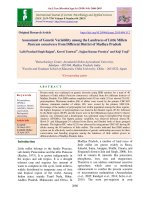
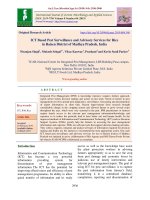
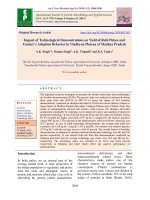
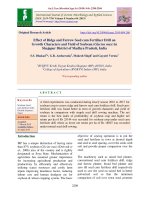
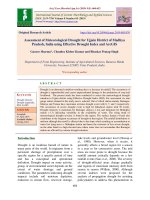

![Growth and yield of Ashwagandha [Withania somnifera (L.)] as influenced by different intercropping system in Kymore plateau of Madhya Pradesh](https://media.store123doc.com/images/document/2020_01/09/medium_vsb1578562778.jpg)
